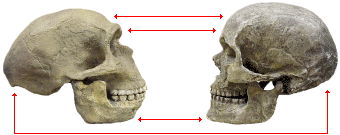
Stone Tools
Homo sapiens took many of the innovations of the Neanderthals and improved on them, specializing the stone tools into smaller more complex, refined tools. This included the composite stone tools 1st created by the Neanderthals (9). Homo sapiens first began by producing long blade knives and spearheads. This was because instead of thrusting into an animal like the Neanderthals once did, Homo sapiens would throw them at their prey. These ideas of throwing, lead to the creation of bow and arrows, fishhooks, harpoons, and spear throwers (12). Homo sapiens unlike Neanderthals began to experiment, the use of their noggin lead to the making tools with other tools. It lead to using different materials such as antler, bone, or ivory for their tools, kits being more versatile and lighter (23). Homo Sapiens began to use smaller tools, leaving the old heavy tools behind. Examples of the tools used by early Homo sapiens are shown here.


This image represents the use of a bow and arrow by early H. sapiens. They used this type of weapon to hunt prey from a safe distance ensuring their survival (27).
The image above represents a bone harpon from early Homo sapiens. The bone harpon was very common for fising. on the sides of the harpons are tips known as barbs, they could latch on to their prey and create a much more drastic injury (25).
The image above is of a spear thrower used by early H. sapiens (25). This toool reinforced the idea that early H. sapiens were begining to hunt from safe distances in order to ensure their survival.





The image to the left represents a cast of one of the stone tools used by early H. sapiens. It represents a cast of an arrow head (7).
The image to the left represent replicas of the stone tools used by Homo erectus and early modern H. sapiens. They also represent tools of the Mousterian industry, used by Neanderthals. From the top, left to right, the tools are Mid-Acheulean bifacial hand ax and Acheulean banded-flint hand ax. In the center is an Acheulean hand tool. On the bottom, from left to right, are a Mousterian bifacial hand ax, scraper, and bifacial point (34).
The image to the left represents stone tools of early H. sapiens from Liang Bua, Mata Menge, and Olduvai Gorge (19). They represent the differences in tevhnique used chronologically through time, with the stones from Olduvai being the oldest, and the stones from Liang Bua being the more modern.
The image above displays the new found ability in using other materials besides stone in making thier tools. Early H. sapines began to experiment with their tool kits in order to make their kits more versatile and light (23). This ability displayed that early H. sapiens were now making tools with other tools and expanding in their cognitive processes.
The image to the left is displaying a comparison of early Homo sapien stone tools. These are some of the tools found in Liang Bua. The comparison of these tools are between tools of early H. sapiens and early H. floresiensis. The circled tools are of the same type but with the tools on the right, being made by H. sapiens. While the tools on the left were constructed by H. floresiensis (19).
